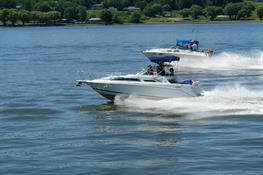
Going for a boat ride is a carefree and fun way to spend your day. Whether out fishing or participating in watersports, it’s always important to remember that no matter what your day entails, every boater should heed the waterway rules. Here’s what you need to know:
Rule #1: The Right-of-Way
Unlike traffic signals and road signs when driving a car, boaters must rely on sound signals, navigation lights, and buoy markers. When approaching another boat on the water, it can be similar to approaching an intersection without stop signs. However, when it comes to boating, there is no right-of-way rule. Instead, boats are defined as the following:
-
The Give-Way Vessel: As the give-way vessel, you must operate your boat to which the stand-on vessel has the right to keep going in its direction. As the give-way vessel, it is your responsibility to signal your intended path to the stand-on vessel. A give-way vessel is also responsible for maneuvering the boat around the other safely.
-
The Stand-On Vessel: As the stand-on vessel, you are responsible for acknowledging the intended direction of the give-way vessel. The stand-on vessel must also continue the current course of speed until the give-way vessel passes.
Rule of thumb: If you are approached by another boat from the stern or port side (left), then you are the stand-on vessel. If you are approached from the starboard (right) side, then you are the give-way vessel.
Failing to follow the above rules can cause a severe boating accident.
Rule #2: Know Your Responsibilities
As the captain of your vessel, you are responsible for operating your boat safely by doing the following:
-
Always operate your boat at a safe and controlled speed.
-
Be sure to follow rules of “no wake” or “slow” water zones.
-
Never operate your boat recklessly, such as under the influence of alcohol or drugs, or speeding.
-
Do not navigate close to naval vessels, and other restricted areas such as bridges and power plants.
-
Always be courteous and respectful to other boaters on the water. For example, keep noise levels to a minimum and refrain from disturbing wildlife.
Rule #3: Understand the Collision Risks
To avoid a boating collision, here’s what every boater should know:
-
Whether it is a foggy night or sunny day, the waterway rules are the same, no matter the visibility conditions.
-
Every boat operator must be alert and have a proper lookout by hearing and sight.
-
Every boat operator must use safe speeds on the water at all times.
By practicing the rules of the waterway, boaters can reduce their risk of being involved in a boating accident.
Involved in a Boating Accident? We’re Here to Help
If you or someone you love has been involved in a boating accident caused by another’s negligence, our team is here to protect your rights. We’re passionate about standing up for plaintiffs’ rights, and we want to fight for you.
Contact DiPasquale Moore today at (816) 888-7500 to schedule a free consultation.

